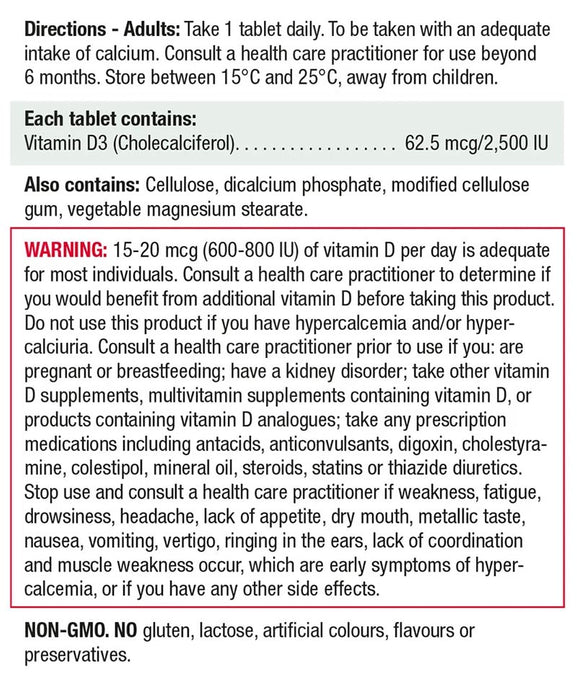
What is Vitamin D?
Vitamin D is a fat-soluble vitamin. Commonly known as the ‘sunshine vitamin’, vitamin D is unique because it can be made by the body through exposure to sunlight. The body’s ability to produce vitamin D is affected by factors such as:1
• Clothing coverage, cloud cover, smog, and sunscreen use.
• Skin pigmentation is also linked to vitamin D levels; those with darker skin pigment (more melanin), have greater difficulty producing vitamin D from the sun.
• The body’s ability to produce vitamin D declines with age; a person aged 70 makes, on average, 25% of the vitamin D that a 20-year old makes when exposed to the same amount of sunlight.
Health Benefits of Vitamin D
Vitamin D is required for bone mineralization and maintenance through the regulation of calcium and phosphorus homeostasis.2 Vitamin D also exhibits effects on other systems of the body, particularly on the immune, endocrine, and cardiovascular systems.2 “The role of vitamin D (25(OH) D) in maintaining optimal health has been well documented,”1 and there is growing awareness that vitamin D insufficiency has serious health consequences beyond rickets and osteomalacia.
Vitamin D Deficiency in Canada
According to Statistics Canada, “25% [of Canadians] are potentially at risk for inadequate vitamin D (between 30 nmol/L and less than 50 nmol/L) and 10% of the population had vitamin D deficiency.”3 During the winter months in Canada, there are fewer ultraviolet B (UVB) photons reaching the earth. This means that very little vitamin D is produced by the body in the winter
• “Approximately 90% of all vitamin D needed by the human body has to be formed in the skin through the action of UV- B-radiation and it has been shown that strict sun protection causes vitamin D-deficiency.
• “Sunscreens indeed impair vitamin D synthesis if they are used in the recommended amount of 2 mg/cm².
Vitamin D is found naturally in only fatty fish, eggs from hens that have been fed vitamin D, and mushrooms
• Mushrooms are the only vegan source available for vitamin D,2 yet the amount is dependent on how much exposure to sunlight or UV light farmers give them. They also lose 20-40% of vitamin D after only 1 week of storage
According to Health Canada, those who reported taking at least one supplement containing vitamin D were more likely to have adequate vitamin D levels (89%) compared with those not taking supplements (66%)
Target Group
• Those with low levels of vitamin D due to avoidance of sun, covering up, and lack of vitamin D foods
• Those who are concerned about their bone health or have a family history of osteoporosis
• Adults over 50 years old; Health Canada reports that the need for vitamin D increases with age
Health Canada Update
Effective Feb 24, 2021, Health Canada has amended the prescription drug list (PDL) to allow non-prescription status (as a natural health product available for self-selection) for products a) containing up to 62.5 mcg or 2,500 International Units (IU)/dosage form for oral use; or b) with a maximum recommended daily oral intake of 2,500 IU.10
Health Canada Claims:
• Helps to prevent vitamin D deficiency.
• Vitamin D intake, when combined with sufficient calcium, a healthy diet and regular exercise may reduce the risk of developing osteoporosis in people with vitamin D deficiency.
Directions:
Adults: Take 1 tablet daily. To be taken with an adequate intake of calcium. Consult a health care practitioner for use beyond 6 months.
Each tablet contains:11
Vitamin D3 (Cholecalciferol) ..................... 62.5 mcg/2,500 IU
Cautions & Warnings:
15-20 mcg (600-800 IU) of vitamin D per day is adequate for most individuals. Consult a health care practitioner to determine if you would benefit from additional vitamin D before taking this product.
Do not use this product if you have hypercalcemia and/or hypercalciuria. Consult a health care practitioner prior to use if you: are pregnant or breastfeeding; have a kidney disorder; take other vitamin D supplements, multivitamin supplements containing vitamin D, or products containing vitamin D analogues; take any prescription medications including antacids, anticonvulsants, digoxin, cholestyramine, colestipol, mineral oil, steroids, statins or thiazide diuretics.
Stop use and consult a health care practitioner if weakness, fatigue, drowsiness, headache, lack of appetite, dry mouth, metallic taste, nausea, vomiting, vertigo, ringing in the ears, lack of coordination and muscle weakness occur, which are early symptoms of hypercalcemia, or if you have any other side effects.

